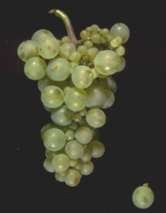Posted by
Unknown
at
00:05
Labels:
Red Wines

Muscat à petits grains (mus-kat ah-petigran) is the official French name for this variety, and means simply Muscat with small berries. There are three colour variants – white, rose and red. The two coloured forms mutate readily from one to the other and to white, but there appear to be two types of white – one is stable and the other mutates to the coloured forms.
The white form seems to predominate in Europe. In Italy the officialname is Moscato Bianco, and there are plantings in other Mediterranean countries. The name Muscat Blanc in California seems to indicate that only the white form is used there, and the plantings in Argentina are listed as Moscato d’Asti, among the white varieties. In South Africa most of the Muskadel, as the variety is known there, are of the red form. In Australia there are 560 ha. A little more than half is the red form and the name Brown Muscat used in north-east Victoria is very appropriate.
The fruit ripens early and, if left on the vine, wilts to give a very high sugar concentration.











